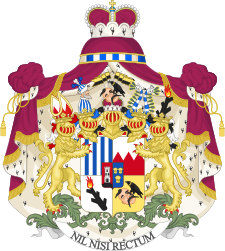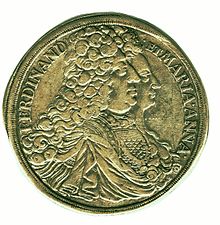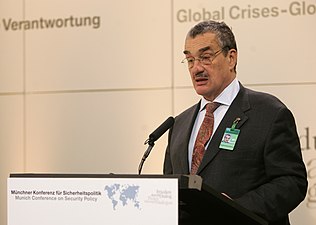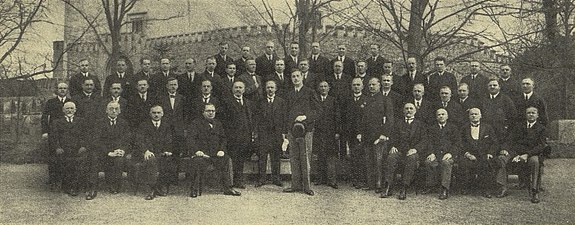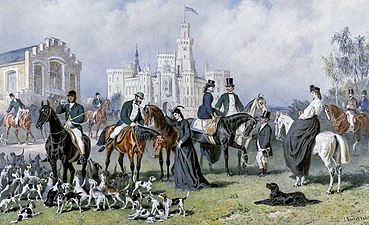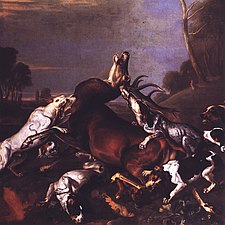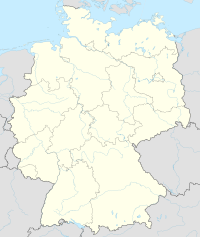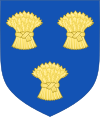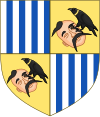
A | B | C | D | E | F | G | H | CH | I | J | K | L | M | N | O | P | Q | R | S | T | U | V | W | X | Y | Z | 0 | 1 | 2 | 3 | 4 | 5 | 6 | 7 | 8 | 9
The House of Schwarzenberg is a German (Franconian) and Czech (Bohemian) aristocratic family, formerly one of the most prominent European noble houses. The Schwarzenbergs are members of the German and Czech nobility, and they once held the rank of Princes of the Holy Roman Empire. The family belongs to the high nobility and traces its roots to the Lords of Seinsheim during the Middle Ages.[1]
The current head of the family is Prince Johannes (born 1967), son and heir of the late Karel, 12th Prince of Schwarzenberg (1937–2023), a Czech politician who served as Minister of Foreign Affairs of the Czech Republic. The family owns properties and lands across Austria, Czechia, Germany, and Switzerland.
History
Origin
The family stems from the Lords of Seinsheim, who had established themselves in Franconia during the Middle Ages.[1] A branch of the Seinsheim family (the non-Schwarzenberg portion died out in 1958) was created when Erkinger of Seinsheim acquired the Franconian territory of Schwarzenberg and the castle of Schwarzenberg in Scheinfeld during the early part of the 15th century. He was then granted the title of Freiherr (Baron) of Schwarzenberg in 1429. At that time, the family also possessed some fiefdoms in Bohemia.
Ascent and expansion
In 1599, the Schwarzenbergs were elevated to Imperial Counts, and the family was later raised to princely status in 1670.[1] In 1623 came the Styrian Dominion of Murau into the Schwarzenberg family due to the marriage of Count Georg Ludwig of Schwarzenberg (1586–1646) with Anna Neumann von Wasserleonburg (1535–1623). Furthermore, the House of Schwarzenberg acquired extensive land holdings in Bohemia in 1661 through a marriage alliance with the House of Eggenberg. In the 1670s, the Schwarzenbergs established their primary seat in Bohemia and, until 1918, their main residence was in Český Krumlov, Bohemia (now in Czech Republic).
Schwarzenberg/Sulz family unification
Due to the absence of a male heir and his only daughter Maria Anna married to Prince Ferdinand of Schwarzenberg, Johann Ludwig II Count of Sulz proposed a family unification between the Counts of Sulz and Princes of Schwarzenberg at the Imperial Court. His request was granted, which not only transferred all legal and property rights upon his death in 1687 from the Sulz family to the Schwarzenberg family, but assured that the Sulz family continues in the Schwarzenberg family. The visible affirmation of this bond was the merging of the coat of arms.
-
Alliance crest on Jinonice castle
-
Ferdinand & Maria Anna
-
Alliance crest on Schwarzenberg Ducat, which was the own currency issued by the House of Schwarzenberg
Two princely lines
At the beginning of the 19th century, the House of Schwarzenberg was divided into two princely-titled lines (majorats).[1] This division was already foreseen in the will of Prince Ferdinand (1652-1703). However, the absence of two male heirs until Joseph II and Karl I Philipp inhibited the execution. The senior branch, which held not only the Palais Schwarzenberg in Vienna, but also the Dominions of Scheinfeld, Krumlov, Frauenberg and Murau, died out in the male line in 1979 upon the death of Joseph III of Schwarzenberg, who was the 11th Prince of Schwarzenberg. The cadet branch, which was established by Karl Philipp, Prince of Schwarzenberg at Orlík Castle, continues to the present day.
The two branches have now been re-united under the father of the current head of the family, Karl VII of Schwarzenberg, who was the 12th Prince of Schwarzenberg. He was a Czech politician and served as Minister of Foreign Affairs of the Czech Republic.
-
The three last Princes of the primogeniture: Adolf (l.), Johann II (m.) and Josef III (r.)
-
The heir of both lines: Karl VII/I
-
The last Prince of the secundogeniture: Karl VI (m.)
Present time
Due to the unification of the family-headship under Karl VII Schwarzenberg, the fidei commissa of both the primogeniture / Hluboka line and the secundogeniture / Orlik line came under the single ownership of the last-mentioned prince. Karl VII created in the 1980s the current structure of the family belongings. The German and Austrian properties from the primogeniture were embedded (with some exceptions) into the Fürstlich Schwarzenberg'sche Familienstiftung (Princely Schwarzenberg Family-Foundation) based in Vaduz. The art collection, which includes the painting The Abduction of Ganymede by Peter Paul Rubens or an important collection of works by Johann Georg de Hamilton, is held in the separate Fürstlich Schwarzenberg'sche Kunststiftung (Princely Schwarzenberg Art-Foundation). The Czech property of the secundogeniture was held until 2023 privately. These properties were in their vast majority also transferred into the Fürstlich Schwarzenberg'sche Familienstiftung. The members of the family follow careers in the private or military sector.
-
RUBENS: The Abduction of Ganymede (between 1611 and 1612)
-
Hunting scene with the Princely family in front of Hluboká Castle in 1865
-
HAMILTON: Hirschhetze (1710)
Frisian and Prussian line
Michael II Baron zu Schwarzenberg (†1469), oldest son of Erkinger I (1362–1437), was married twice. First with Gertrud (Bätze) von Cronberg (†1438), from whom the princely line descends. His second marriage was with Ursula (Frankengrüner) Grüner (†~1484), from whom the Frisian and later the Prussian line originates. The children of Michael's and Ursula's alliance were never recognized by their half-siblings, as their first born son was born out of wedlock and the legitimisation only took place with the subsequent wedding.
Johann Onuphrius (1513–1584), a great-grandson of Michael II and Ursula, is considered to be the progenitor of the Frisian Line. His marriage with Maria von Grumbach (†1564) ensured Groot Terhorne Castle until 1879 as the family seat in the Netherlands. The Frisian line was made a member of the Dutch nobility by a Royal decree of King William I of the Netherlands on August 28, 1814. Henceforth, the Dutch version thoe Schwartzenberg en Hohenlansberg was applied for this branch of the family.
The Prussian Line was established as a cadet branch of the Frisian line with Georg Baron thoe Schwartzenberg en Hohenlansberg (1842–1918), who served as a Rittmeister in the Imperial German Army. He and his descendants were made members of the Prussian nobility by an Imperial decree, issued by Emperor Wilhelm II, and are entitled to carry the German title Freiherr.
Imperial immediate estates
The Schwarzenberg family held three Imperial Immediate Estates in the Holy Roman Empire.
By coincidence the coat of arms of the Princely Landgraviate of Klettgau and the Earldom of Buchan in Scotland are the same. The Klettgau coat of arms can be found in the left heart shield of the Schwarzenberg coat of arms.
Notable family members
The House of Schwarzenberg produced many military commanders, politicians, church dignitaries (including a Cardinal), innovators and patrons of the arts.[1] They were related to a number of European aristocratic families, notably the Lobkowicz (Czech: Lobkovicové) family. Some of the most noteworthy members of the Schwarzenberg family are:
| Name | Portrait | Arms | Office(s) | Marriage(s) Issue |
Comments |
|---|---|---|---|---|---|
| Erkinger VI of Seinsheim, 1st Baron of Schwarzenberg 1362 – 11 December 1437 |

|

|
Grand Master of the Hunt at the Court of the Bishopric of Würzburg | I. Anna von Bibra 1348 – 1408 Six children II. Barbara von Abensberg 1383 – 2 November 1448 Eleven children |
Founder of the Schwarzenberg family Member of the Imperial Council Military commander in the Hussite Wars |
| Johann, Baron of Schwarzenberg Johann the Strong 25 December 1463 – 21 October 1528 |

|

|
Judge of the episcopal court at Bamberg | Kunigunde, Countess of Rieneck 28 September 1469 – 18 October 1502 twelve children |
Friend of Martin Luther, and author of the Constitutio Criminalis Bambergensis, which was the basis for the Constitutio Criminalis Carolina |
| Wilhelm I, Baron of Schwarzenberg 1486 – KIA 1526 |

|
Field marshal | Katharina Wilhelmina von Nesselrode ? – 6 December 1567 two sons |
Field marshal of the Holy Roman Empire under Emperor Charles V in: German Peasants' War Guelders Wars | |
| Otto Heinrich, Count of Schwarzenberg Known among his contemporaries as inter viros sui temporis illustres illustrissimus 1535 – 11 August 1590 |

|

|
President of the Aulic Council Hofmarschall of the HRR by his Imp. Maj. decreed Guardian and Governor in Baden |
Elisa Margareta von Wolff Metternich ? – 6 February 1624 one son |
Guardian and Governor in Baden for Margrave Philip II of Baden President of the Aulic Council and Hofmarschall of the HRR under Maximilian II and Rudolf II |
| Melchior, Baron of Schwarzenberg ca. 1536 – KIA 29 June 1579 |

|
Military Commander Military Governor |
Anne de Merode-Houffalize ca. 1530 – 1580 |
Commander of the Dutch States Party military forces in the Siege of Maastricht and Military Governor of Maastricht | |
| Adolf, Count of Schwarzenberg ca. 1547 – 29 July 1600 |

|

|
Field marshal | Elisa Margareta von Wolff Metternich ? – 6 February 1624 one son |
Field marshal of the Holy Roman Empire and liberator of Raab, Hungary |
| Adam, Count of Schwarzenberg 1583 – 14 March 1641 |

|

|
Herrenmeister (Grand Master) Political advisor |
Margareta, Freiin von Palant von Larochette und Moestroff ? – 29 September 1615 two sons |
Advisor of George William, Elector of Brandenburg, Herrenmeister (Grand Master) of the Order of Saint John Son of Adolf, Count of Schwarzenberg |
| Georg Ludwig, Count of Schwarzenberg 24 December 1586 – 22 July 1646 |

|
Statesman | I. Anna Neumann von Wasserleonburg 25 November 1536 – 18 December 1623 no issue II. Maria Elisabeth Countess of Sulz 1587 – 12 December 1651 two sons |
Austrian statesman during the Thirty Years War Through his marriage with Anna Neumann came the Dominion of Murau into the Schwarzenberg family | |
| Ferdinand, 2nd Prince of Schwarzenberg The Plague King 23 May 1652 – 22 October 1703 |

|

|
Oberhofmarschall Oberhofmeister |
Maria Anna Countess of Sulz ca. 1660 – 18 July 1698 eleven children |
Oberhofmarschall and Oberhofmeister, known as the Plague King (Pestkönig) |
| Adam Franz, 3rd Prince of Schwarzenberg Duke of Krumlov 25 September 1680 – 11 Juni 1732 |

|

|
Obersthofmarschall (1711–1722) Oberstallmeister (1722–1732) |
Eleonore Princess of Lobkowicz 20 June 1682 – 5 May 1741 two children |
First Duke of Krumlov, Count of Sulz and Princely Landgrave of Klettgau in the Schwarzenberg family Initiator of the Schwarzenberg Navigational Canal Killed accidentally by Emperor Charles VI during a driven shoot |
| Joseph I, 4th Prince of Schwarzenberg Duke of Krumlov 15 December 1722 – 17 February 1782 |

|

|
Obersthofmeister | Maria Theresia Princess von und zu Liechtenstein 28 December 1721 – 19 January 1753 nine children |
Obersthofmeister of Empress Maria Theresia, Minister of State, receives the Order of the Golden Fleece at the age of ten |
| Joseph II, 6th Prince of Schwarzenberg Duke of Krumlov 27 June 1769 – 19 December 1833 |

|

|
Ambassador | Pauline Princess of Arenberg-Aarschot 2 September 1774 – burned to death in the night of 1–2 July 1810 nine children |
Ambassador of the Austrian Empire in Paris Last Prince of Schwarzenberg, who possessed the imperial immediacy Founder of the Schwarzenberg Primogeniture |
| Karl Philipp Prince of Schwarzenberg 15 April 1771 – 15 October 1820 |

|

|
Field marshal Ambassador |
Maria Anna Countess von Hohenfeld widowed Princess Esterházy 20 May 1768 – 2 April 1848 three sons |
Austrian field marshal during the Napoleonic Wars and ambassador in St.Petersburg and Paris, Generalissimo of the Sixth Coalition in the Battle of the Nations at Leipzig Founder of the Schwarzenberg Secundogeniture |
| Ernst Prince of Schwarzenberg 29 May 1773 – 14 March 1821 |

|
 Bishop Zdroj:https://en.wikipedia.org?pojem=House_of_Schwarzenberg Text je dostupný za podmienok Creative Commons Attribution/Share-Alike License 3.0 Unported; prípadne za ďalších podmienok. Podrobnejšie informácie nájdete na stránke Podmienky použitia.
Analytika
Antropológia Aplikované vedy Bibliometria Dejiny vedy Encyklopédie Filozofia vedy Forenzné vedy Humanitné vedy Knižničná veda Kryogenika Kryptológia Kulturológia Literárna veda Medzidisciplinárne oblasti Metódy kvantitatívnej analýzy Metavedy Metodika Text je dostupný za podmienok Creative
Commons Attribution/Share-Alike License 3.0 Unported; prípadne za ďalších
podmienok. www.astronomia.sk | www.biologia.sk | www.botanika.sk | www.dejiny.sk | www.economy.sk | www.elektrotechnika.sk | www.estetika.sk | www.farmakologia.sk | www.filozofia.sk | Fyzika | www.futurologia.sk | www.genetika.sk | www.chemia.sk | www.lingvistika.sk | www.politologia.sk | www.psychologia.sk | www.sexuologia.sk | www.sociologia.sk | www.veda.sk I www.zoologia.sk |

